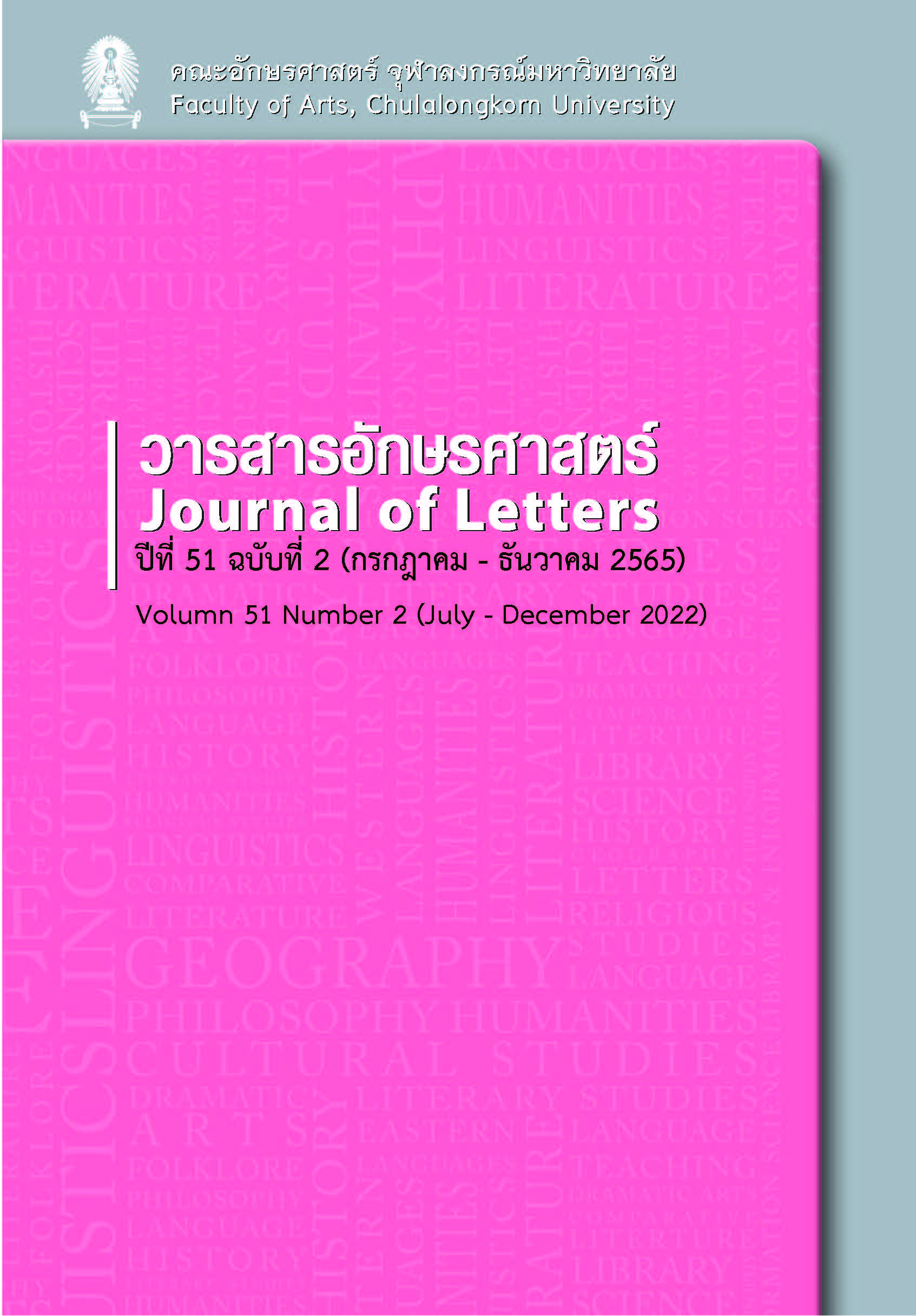ความสัมพันธ์ระหว่างเกณฑ์การจัดหมู่อัญมณีในยุกติกัลปตรุ ของโภชะ กับหลักอายุรเวท
คำสำคัญ:
ศาสตร์แห่งอัญมณีอินเดีย, วรรณคดีสันสกฤตประเภทศาสตร์, ยุกติกัลปตรุ, ปรัชญาไวเศษิกะ, อายุรเวทบทคัดย่อ
ในรัตนปรีกษาฉบับยุกติกัลปตรุซึ่งประพันธ์โดยพระเจ้าโภชะ อัญมณีสำคัญบางชนิดได้รับการจัดหมู่โดยใช้เกณฑ์หลายรูปแบบเกณฑ์ส่วนใหญ่อ้างถึงแนวคิดทางอายุรเวท ซึ่งจำเป็นต้องมีการศึกษาค้นคว้าเพื่อพิสูจน์ความเที่ยงตรงของข้อมูล บทความวิจัยนี้มุ่งศึกษาเกณฑ์การจัดหมู่อัญมณีประเภทเพชรและไข่มุกในรัตนปรีกษาฉบับยุกติกัลปตรุโดยเน้นเกณฑ์ที่เกี่ยวข้องกับหลักวิชาอายุรเวท และศึกษาในแง่ของลักษณะการจัดหมู่ภายในตัวบทและความเชื่อมโยงระหว่างตัวบทกับหลักวิชาอายุรเวท ผลการศึกษาแสดงให้เห็นความสัมพันธ์ระหว่างการจัดหมู่อัญมณีกับหลักการพื้นฐานของอายุรเวทอย่างมีนัยสำคัญ ได้แก่ ปัญจมหาภูตะ ตริโทษะ รวมถึงวรรณะ 4 ซึ่งสามารถเชื่อมโยงกับพื้นฐานของอายุรเวทได้ด้วย ส่วนความคลาดเคลื่อนของการนำเสนอข้อมูลพบค่อนข้างน้อย ลักษณะเช่นนี้แสดงว่าผู้แต่งยุกติกัลปตรุมีแนวโน้มที่พยายามนำหลักอายุรเวทมาประยุกต์ใช้กับการตรวจสอบคุณสมบัติของอัญมณี อีกทั้งสะท้อนธรรมชาติของงานนิพนธ์ประเภทศาสตร์ของอินเดียที่ผสมผสานความรู้ต่างสาขาเข้ากับความรู้มูลฐาน เพื่อให้การศึกษาความรู้มูลฐานเป็นไปโดยกระจ่างและลึกซึ้ง
References
ภาษาไทย
Aroonwan Kongmebhol อรุณวรรณ คงมีผล. (2018). Sarattha lae khwam samkhan khong sat haeng anyamani India boran สารัตถะและความสำคัญของศาสตร์แห่งอัญมณีอินเดียโบราณ [Essence and significance of ancient Indian lapidaries] [Doctoral dissertation, Chulalongkorn University]. CUIR. http://cuir.car.chula.ac.th/handle/123456789/73364
Sunthorn Na-Rangsi สุนทร ณ รังษี. (2002). Pratya India: Prawat lae Latthi ปรัชญาอินเดีย: ประวัติและลัทธิ [Indian philosophy: History and thought]. Chulalongkorn University Press.
Thewan Thaneerat et al. เทวัญ ธานีรัตน์ และคณะ (Eds.). (2008). Tamra wichakan ahan phuea sukkhaphap ตำราวิชาการอาหารเพื่อสุขภาพ [Food-for-Health textbook]. Department of Thai Traditional and Alternative Medicine.
ภาษาอังกฤษ
Balkrishna, A. (2015). A practical approach to the science of Ayurveda: A comprehensive guide for healthy living. Lotus Press.
Bhaurao, D. S. (2017). Understanding the concept of Varnotpatti in Ayurveda. International Journal of Innovative Research in Medical Science 2(9), 1341-1345.
Janki, S. S. (2003). Ayurveda (Sanskrit). In A. Datta (Ed.), Encyclopaedia of Indian literature: A-Devo (Vol. 1, pp. 310-311). Sahitya Akademi.
Oldenberg, H. (1997). The doctrine of the Upaniṣads and the early Buddhism. Motilal Banarsidass.
Patel, S., Bhagat, V. V., & Rathod, K. (2019). A comprehensive and comparative view of GUNAS in Ayurveda and Vaisesika philosophy. International Journal of Advanced Research, 7(7), 576-587. http://dx.doi.org/10.21474/IJAR01/9397
Ramesh, G., & Yadav, C. R. (2017). Interrelation between tridosa & triguna. International Ayurvedic Medical Journal, 5(9), 3540-3548.
Revankar, R. G. (1971). The Indian constitution--A case study of backward classes. Associated University Press.
Roy, M. (2006). Āyurveda. In P. Ray & S. N. Sen (Eds.), The cultural heritage of India vol. VI: Science and technology (pp. 152-176). The Ramakrishna Mission Institute of Culture, Kolkata.
Singh, L. M. (1999). Doṣa in Āyurveda. In K. Advaitavadini & C. Sukumar (Eds.), Kalātattvakośa: A lexicon of fundamental concepts of the Indian arts vol. IV: Manifestation of nature (pp. 218-226). Indira Gandhi National Centre for the Arts and Motilal Banarsidass.
Tirtha, S. S. (2005). The Āyurveda encyclopedia: Natural secrets to healing, prevention & longevity (5th ed.). Ayurveda Holistic Center Press.
Walker, B. (1995a). Humours. In Hindu world: An encyclopedic survey of Hinduism vol. I: A-L (pp. 466-467). Indus.
Walker, B. (1995b). Substance. In Hindu world: An encyclopedic survey of Hinduism vol. II: M-Z (pp. 440-442). Indus.
ที่มาของต้นฉบับงานนิพนธ์สันสกฤต พร้อมอักษรย่อ
CS. Caraka-Saṃhitā (500 B.C. - A.D. 400)
Sharma, P. V. (1998). Caraka Saṃhitā (Text with English Translation). Chaukhambha Orientalia.
SS. Suśruta-Saṃhitā (500 B.C. - A.D. 500)
Āchārya, N. R. (Ed.). (1945). The Suśrutasaṃhitā of Suśruta: With various readings, notes and appendix, etc. Satyabhāmābāī Paṇḍurang.
YKT. Yuktikalpataru of Bhojarāja (A.D. 1075)
Sastri, P. I. C. (Ed.). (2018). Yuktikalpataruḥ mahārāja-śrībhoja-viracitaḥ (Yuktikalpataru by King Bhoja). In Aroonwan Kongmebhol, Sarattha lae khwam samkhan khong sat haeng anyamani India boran สารัตถะและความสำคัญของศาสตร์แห่งอัญมณีอินเดียโบราณ [Essence and significance of ancient Indian lapidaries] (pp. 160-282). [Doctoral dissertation, Chulalongkorn University]. CUIR. http://cuir.car.chula.ac.th/handle/123456789/73364 (Original work published 1917)
Downloads
เผยแพร่แล้ว
How to Cite
ฉบับ
บท
License

This work is licensed under a Creative Commons Attribution-NonCommercial-NoDerivatives 4.0 International License.
การป้องกันปัญหาด้านลิขสิทธิ์และการคัดลอกผลงาน
ผู้เขียนบทความมีหน้าที่ในการขออนุญาตใช้วัสดุที่มีลิขสิทธิ์คุ้มครองจากเจ้าของลิขสิทธิ์ ผู้เขียนบทความมีความรับผิดชอบที่จะต้องปฏิบัติตามกฎหมายในการคัดลอกและทำสำเนาวัสดุที่มีลิขสิทธิ์อย่างเคร่งครัด การคัดลอกข้อความและการกล่าวพาดพิงถึงเนื้อหาจากวัสดุตีพิมพ์อื่น ต้องมีการอ้างอิงแหล่งที่มากำกับและระบุแหล่งที่มาให้ชัดเจนในส่วนบรรณานุกรม การคัดลอกข้อความหรือเนื้อหาจากแหล่งอื่นโดยไม่มีการอ้างอิงถือเป็นการละเมิดจริยธรรมทางวิชาการที่ร้ายแรง และเข้าข่ายการละเมิดลิขสิทธิ์ตามพระราชบัญญัติลิขสิทธิ์ พ.ศ. 2537 หากมีการฟ้องร้องดำเนินคดีใด ๆ เกิดขึ้น ผู้เขียนบทความมีความรับผิดชอบทางกฎหมายแต่เพียงผู้เดียว


